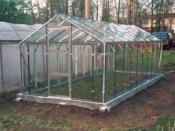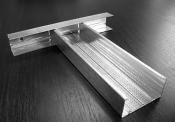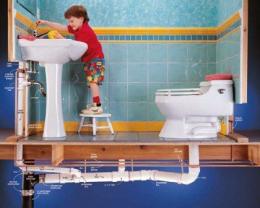Search
Login
Recommended
We choose sewer pipes, how to choose the right pipe for sewer yourself, expert advice
Today, it is unlikely to be able to meet an apartment or a house where there are no engineering systems, the development of which was carried out in accordance with modern technological requirements. The fundamental of them is the drainage system. If a few decades ago, only cast iron and steel were used for the production of sewer pipes, then due to the development of innovative technologies, they lost their former popularity, since materials with higher performance characteristics appeared. Given this, we can conclude that at the moment the most acute question is the choice of material for sewer pipes, since their quality and the subsequent characteristics of the drainage system depend on this parameter. If you have planned the construction of a house or major repairs and do not have experience in choosing sewer pipes, the materials in this article will help you deal with the difficulties of choosing pipes for sewer systems. We will try to acquaint readers with the classification of pipes for the drainage system, as well as talk about their advantages and weaknesses, which, in our opinion, will help to make the right choice.
Content
- Basic materials for sewer pipes. What to choose?
- Ceramic and asbestos-cement pipes video
- Cast iron pipes. What is the reason for their limited use?
- The main varieties of plastic pipes: PVC pipes video
- Corrugated sewer pipes: main advantages
Basic materials for sewer pipes. What to choose?
The market of materials for construction offers the widest selection of sewer pipes made from the following materials:
1. Asbestos and concrete;
2. Ceramics;
3.Metal;
4. Polymeric materials;
5. Separate corrugated pipes. For their manufacture, polyethylene is used.

Ceramic and asbestos-cement pipes
Ceramic pipes are rarely used in the process of installation of water disposal systems, in connection with which it is advisable to pay more attention to other materials.

Pipes made from asbestos cement are represented on the market, in most cases, by products of domestic producers. Their cost is significantly lower than the price of sewer plastic pipes and pipes made of cast iron, but transportation contributes to a significant increase in the price range. Among the main advantages of pipes from the specified material, high tensile strength can be distinguished, due to which the free use of the specified type of pipes is practiced in the construction process of both pressureless and pressure drainage systems.

A significant role in this process is assigned to asbestos, which under the influence of the aquatic environment only hardens, which also eliminates the possibility of corrosion.


It is worth noting that today the use of ceramic and asbestos-cement pipes in the installation of engineering systems is so rare that the description of the characteristics of pipes made of these materials does not play a significant role.
Cast iron pipes. What is the reason for their limited use?
Even 10-20 years ago, cast iron was considered the most popular material for sewer pipes. Now this is less common, but still practiced. There are two types of pipes made of cast iron used in the installation process for the creation of sewer structures:

1. Pipes for the manufacture of which gray cast iron was used are characterized by relatively low dynamic resistance;
2. Pipes made of malleable cast iron and characterized by wider application, which is due to high resistance to stress and excellent plastic properties.

The characteristic advantages of cast iron sewer pipes are the following:
1. High strength indicators;
2. The duration of the operational period;
3. Ability to withstand high level loads;
4. The presence of plastic properties.

Among the shortcomings can be identified:

1. The roughness of the inner surface, as a result of which the passage of sewage through pipes is much more difficult;
2. Difficulties of transportation and subsequent installation due to the large mass;
3. The need to use during the installation process additional materials to ensure the tightness of the joints between the pipes;
4. High cost.

The main varieties of plastic pipes: PVC pipes
Another type of sewer pipes, the use of which is actively practiced on the construction sites of our time, are pipes made of polyvinyl chloride (PVC). The characteristics and technical features of PVC sewer pipes make it possible to use them for installation of both external and internal sewer systems.


Technological features of the production of plastic sewer pipes and differences in the chemical structure of the polymers used for their manufacture allow us to distinguish the following varieties:

1. Polypropylene pipes;
2. Pipes, the production of which is carried out from unplasticized polyvinyl chloride;
3. PVC pipes.


High strength indicators of PVC pipes, as well as low expansion rates make it possible to use them for installation of external and internal sewage systems. Resistance to ultraviolet radiation makes it possible to use PVC pipes in gravity-type sewers.

Among the shortcomings, it is important to note:
1. Decrease in strength characteristics under the influence of low temperatures;
2. Tendency to deformation under the influence of temperature over 70 degrees;
3. In case of fire, combustion with the formation of extremely toxic phosgene;
4.Low resistance to chemical aggressors.
When choosing an external sewer pipe, it is also advisable to give preference to unplasticized polyvinyl chloride, which, among other things, has been successfully used in the production of pipes for internal sewers.

Due to properties close to the characteristics of PVC sewer pipes, they can be selected for installation of cold water sewer systems, however, a low range of operating temperatures and easy flammability limit the mass use of unplasticized PVC.

As practice shows, choosing pipes for internal sewage, it will be most optimal to make a choice in favor of pipes made of polypropylene, however, despite the greater softness compared to other polymers, resistance to temperature factors and operational reliability, experts do not recommend using them for installation of external sewage. The reason for this is the high softness of polypropylene pipes, which is a direct risk of deformation during installation or damage during operation.

The main advantage inherent in all types of plastic pipes is the highest throughput, due to the smoothness of the inner walls. Blockages in such pipes are considered a rarity, with the exception of cases of significant kinks and sharp turns, which, by the way, need to be avoided or made as smooth as possible.

Corrugated sewer pipes: main advantages
We should also talk about corrugated pipes, the manufacturing technology of which involves the use of polyethylene.

They are profiled polyethylene structures consisting of two layers, which are used not only for the installation of external sewer systems, but also for the removal of groundwater.

Production measures for the manufacture of corrugated sewer pipes are carried out by extrusion of two walls, as a result of which the outer surface of the pipe is corrugated, and the inner surface is smooth.

Such a structure and high rates of ring stiffness prevent clogging of the inner hole, and also provide resistance to external influences. The minimum weight indicators (in comparison with other types of pipes) provide low material and physical costs during their transportation and installation of water disposal systems, and also allow installation measures to be taken at a depth exceeding 15 m.






